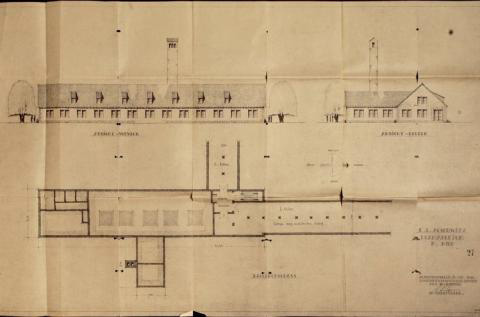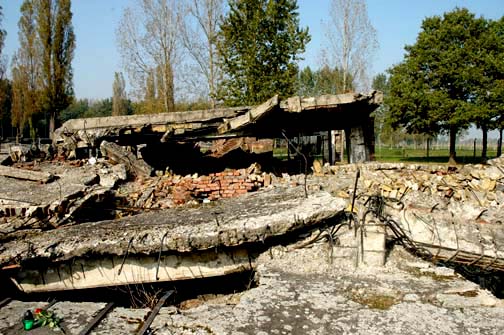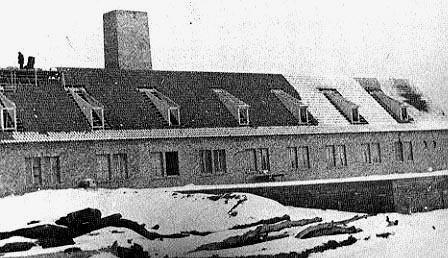Ruins of Krema II at Auschwitz-Birkenau
 Ruins of Krema II ,
October 2005
Ruins of Krema II ,
October 2005
 Ruins of Krema II,
February 1945
Ruins of Krema II,
February 1945
Krema II at Auschwitz-Birkenau was the
site of the largest mass murder in the history of mankind. It
was here that over 500,000 Jews were gassed to death with Zyklon-B,
an insecticide that was also used to disinfect clothing in the
camp, according to Robert Jan Van Pelt, a noted Holocaust historian.
The old black and white photo above was
taken shortly after Auschwitz was liberated by the Soviet Union
on January 27, 1945. The photo at the top of the page shows the
same view of the ruins of Krema II, taken in October 2005. The
trees in the background are at the west end of the Auschwitz
II camp, aka Birkenau.
The two photos show the on-goning effort
to preserve the ruins of the Krema II. Van Pelt calls Krema II
the "Holy of Holies." It is a place that demands great
reverence and respect for the thousands of innocent victims who
perished here.

Ruins of Krema II gas
chamber, looking north towards International Monument
The photo above shows the ruins of the
Krema II gas chamber building at Birkenau, taken with the camera
facing north. In the center of the photo is what appears to be
a hole in the ruins of the concrete roof, made when the building
was blown up with dynamite on January 20, 1945.
Krema II was a one-story brick building
with an attic and two underground rooms, located on the south
side of the main camp road in the Auschwitz II camp, aka Birkenau.
Krema III, located on the north side of the main camp road, was
a mirror image of Krema II. The gas chambers in both Krema II
and Krema III were in underground rooms situated in a north-south
direction. The ground-floor brick buildings which housed the
ovens in both Krema II and Krema III were situated in an east-west
direction, forming a T-shape. The English word for Krema is Crematorium.
In the photo above, the collapsed roof
of the underground gas chamber in Krema II can be seen in the
foreground. The ruins of the undressing room, which is at right
angles to the gas chamber, can be seen on the left. The International
Monument, built in 1965, is in the background.
In November 2008, the blueprints of some
of the Birkenau buildings were found in an apartment in Berlin,
according to this news story. The blueprint for the disinfection building at
Birkenau showed a gaskammer, which means gas chamber in English.
The blueprint for Krema II is shown in
the photo below. Krema III was a mirror image of Krema II.
 Blueprint of Krema
II building, found in a Berlin apartment
Blueprint of Krema
II building, found in a Berlin apartment
On the blueprint shown above, the undressing
room is on the right. To the left of the undressing room is the
above-ground oven room with the ovens designated by 5 squares.
The gas chamber is perpendicular to the undressing room. On the
blueprint, the gas chamber is labeled L-keller which is an abbreviation
for Leichenkeller, which means corpse cellar in English. The
undressing room was also called a Leichenkeller on the blueprint.
There was an exterior entrance with a
staircase on the north side of the building which led to the
Vorraum of Krema II so that the SS men could enter Leichenkeller
1, the gas chamber, without going through Leichenkeller 2, which
was the undressing room. In case of emergency, the gas chamber
could be used as a bomb shelter for the SS men working in the
area, since it had a gas-tight air raid shelter door.
The Krema II and Krema III buildings
were originally planned to be built in the Auschwitz I main camp.
The original blueprints showed a corpse slide which was located
at the intersection of Leichenkeller I and Leichenkeller 2 so
that dead bodies could be rolled into the two corpse cellars.
When Krema II and Krema III were built at Birkenau instead, the
corpse slide was replaced by stairs on the side of the building
which faced the main camp road, which was the north side for
Krema II and the south side for Krema III. These stairs, facing
the main camp road, were for the use of the SS men; the gas chamber
victims used the stairs which went down into Leichenkeller 2;
these stairs faced the north-south road which intersected the
main camp road. This intersection no longer exists because the
International Monument was built on top of the main camp road
at the west end of the camp.
For maximum effectiveness, the manufacturer's
recommendation was that the Zyklon-B pellets, which were used
for gassing the prisoners, should be heated to 78.3 degrees and
that the poison gas should be circulated throughout the room
by the use of a blower, but Krema II had no device for heating
the pellets, nor for circulating the gas.
According to the testimony of survivors,
Krema II did have a ventilation system with vents on the roof
to air out the room after the gassing, since there was only one
door into the gas chamber and the room could not be properly
ventilated just by opening the door. The ventilation for both
the undressing room and the gas chamber at both Krema II and
Krema III was included on the blueprints and the ventilation
system was mentioned in other documents pertaining to these buildings.

View of the ruins of
Krema II oven room
 Roof of Krema II gas
chamber in the right foreground, 1943
Roof of Krema II gas
chamber in the right foreground, 1943
The old photo above shows the Krema II
building in 1943 when it was under construction; the roof of
the partially-underground gas chamber, covered with about two
inches of snow, is on the right. The ceiling of the gas chamber
room was around eight feet high; the exterior roof was about
three feet above ground.
There were four holes in the roof of
the gas chamber in both Krema II and Krema III; the roofs were
made of reinforced concrete, six inches thick. Through these
four holes on the roof, an SS man, wearing a gas mask, lowered
an open can of Zyklon-B gas pellets down into four wire-mesh columns inside the gas chamber.
When the gassing was finished, the pellets were retrieved and
sent back to the Degesch company so that they could be reused.
Michael Kula, a survivor, testified as an eye-witness to the
use of wire-mesh columns for the Zyklon-B pellets, but these
columns are no longer in existence.
This YouTube video of the ruins of Krema II show what
is purported to be "evidence of one of the holes" in
the roof of Krema II where Zyklon-B pellets were put into one
of the columns.
On January 18, 1945, the Germans abandoned
the Auschwitz-Birkenau complex, and on January 20, 1945, the
Krema II gas chamber was blown up with dynamite. The 210-square-meters
underground gas chamber room survived the blast and it is still
partially intact. It is possible to climb down into the southernmost
quarter of the Krema II gas chamber through a hole in the roof;
a few people have descended into the ruins of the gas chamber
without permission, including two revisionists who have written
unofficial and controversial reports about
the condition of the walls, which they claim do not show the
blue stains caused by heavy use of Zyklon-B poison gas. However,
the narrator of this video says "I have been under this gas
chamber. The walls themselves look in the concrete absolutely
lined with blue which suggests that this was cyanide."
This page was last updated on February
24, 2010
|